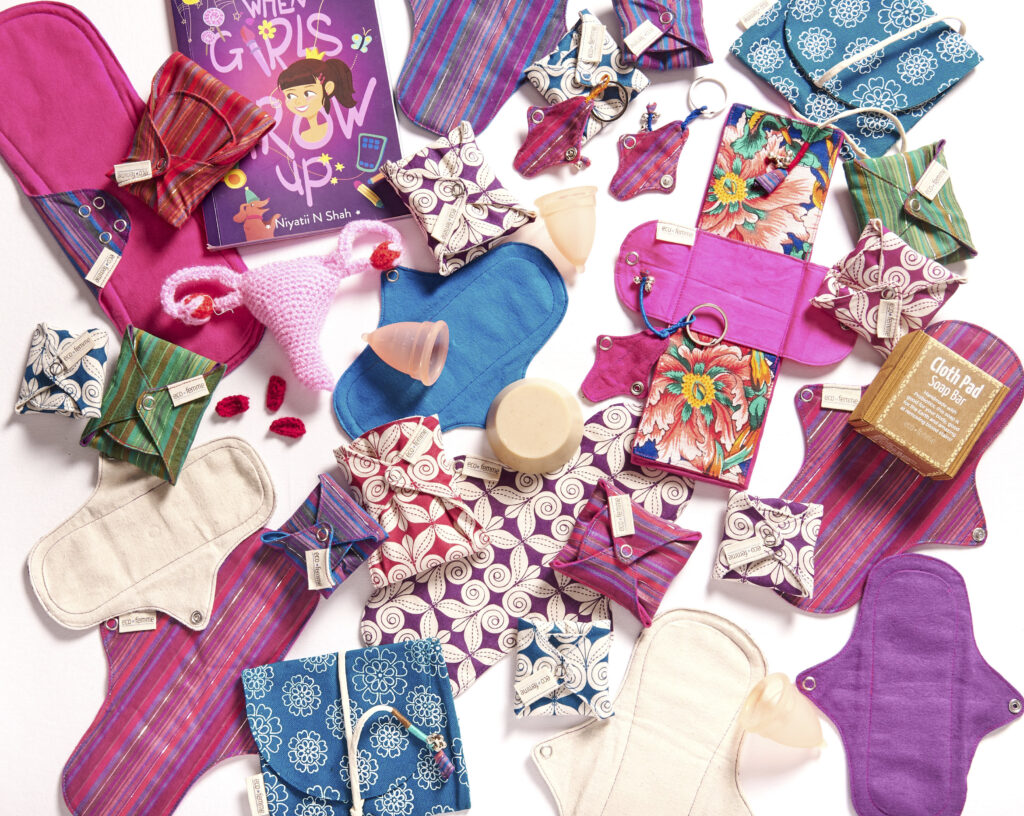By Stephanie Kraus
Every month a woman that menstruates uses some kind of method to handle her blood flow. We can see the blood going into the pad, into the tampon or menstrual cup and into the toilet basin. But have you ever wondered how much do you bleed? What is the actual amount of blood which your body expels during your period? What’s a normal flow, heavy flow or light flow? And have you ever wondered if other mammals also have periods? Why do humans need menstrual products to catch the blood, ever heard of ‘Natural Menstruation’? Can you do something for yourself about a heavy flow?
Here are some more facts about period blood.
What is the normal amount of Human Period Blood?
“Normal” can be a pretty difficult concept to handle and any deviation can make us feel “abnormal” and insecure about ourselves. This isn’t necessary. While it is important to pay attention to be healthy, each woman has a different body: short, tall, big pelvis, small pelvis, age, puberty, mother of three or progressing to menopause, on birth control or hormones or not, and… a different period! All such factors can have an effect on the amount of period flow. Finally, what can be an issue for one woman can be absolutely normal for another woman. So let’s refer to the concept of “average” which includes the full range of menstruating woman and find the middle.
Most women experience a blood flow between 10-80 ml, during 2 to 7 days and the average amount of blood that a woman’s body expels during her menstruation is be found to be 35 ml.
If you feel unsure about your period you can consult a health practitioner. To learn more about heavy periods, check out this link by NHS UK.
How much Blood can a Menstrual Pad or Tampon or Cup hold?
A fully soaked medium absorbency pad or tampon holds a teaspoon (5ml) of liquid (for a particular product brand please refer to the product information). For a usual length of menstruation of 4 to 6 days with an average of 35 ml for the whole cycle, all we need is about 6 sanitary products. While we change more frequently due to reasons of spilling, showering and changing clothes, or feeling uncomfortable and simply ready for a change. A menstrual cup holds about 25 ml, depending on the model and depending on your flow you can wear it up to 12 hours.
How to track and measure your Menstrual Flow?
The possible methods for this are measuring, weighing and/or chemical test.
- If you are using a menstrual cup, this is easiest. Many cup models actually have metric lines for you to read how much liquid is inside once you take it out. Even if the particular cup doesn’t, it is easy to take a teaspoon and just measure the number of teaspoons (5ml) through pouring the blood onto it.
- If you are using pads or tampons, measuring is a bit more tricky. You will have to estimate that one fully soaked, normal size sanitary product will hold about 5ml, (for a particular product brand please refer to the product information), add up all the products used. While making your judgement pay attention to the number of items that you changed half full.
- You can also weigh the pads or tampons after use, add up the amount and then subtract the weight of the same unused products. Dried blood weighs less than wet blood. And your results will be a weight rather than a liquid quantity.
- The most exact method is a chemical process. This is not practical to be applied at home, but can be used for lab testing and scientific studies (2).
Note: Consider while using any of the above measuring methods that the number can contain sweat as well as other body fluids. And there might be alterations because of evaporation of fluids.
Do other Mammals also have Periods?
The answer is ‘yes, but….’. All female mammals that produce offspring with a placenta, build up a uterine lining (the endometrium) in the fertile phase of their cycle and dismantle it in the infertile phase. Some species have an ‘estrous cycle’, in which, if no conception takes place, the endometrium fluids are reabsorbed into the body (covert menstruation). Other species, like the human have a ‘menstrual cycle’, where the body expels the endometrium lining (overt menstruation). Primates, some bat species and elephants also experience overt menstruation. But, here’s an inspiring detail: Before menstruating, humans do in fact also reabsorb two-thirds of the liquid in the endometrium (3).
Food for thought: If human beings actually do have the ability to reabsorb endometrial liquid, why do some women menstruate so much blood? Maybe there is something about human beings that can cause this? Could this possibly be a factor we can influence and reduce strong periods?
Can I do anything about a Heavy Flow?
While excess bleeding can be a sign for a health concern, in fact what you feel might be ‘a lot of blood’ might actually be alright. As mentioned above, every woman’s body is different and the amount of blood can also change throughout her menstruating years. In case if you feel uncomfortable about the amount of your menstrual blood, you can refer to a health practitioner.
There are some health practitioners who mention using hormonal birth control pills to regulate menstrual bleeding, while others point out that this should really be reserved for health-threatening blood loss conditions, and not for popular comfort. They point out the warning that ‘the pill’ in general is a possibly disturbing intervention into a woman’s natural hormonal system with potential health concerns. Although this is not a topic for detailed discussion in this article.
Holistic possibilities to regulate a Heavy Menstrual Flow:
However there are also more holistic possibilities to regulate a heavy menstrual flow.
-
Physical exercise can support a healthy menstruation:
Something you might be able to do to help yourself is practice the AVIVA Method, a set of exercises developed by Aviva Steiner with a positive effect on a variety of complaints of the female reproductive system including heavy menstrual bleeding. Coming back to the ‘food for thought’ above, two-thirds of endometrial liquid can be reabsorbed into the body before menstruation, and this could possibly be a factor to influence and reduce strong periods. The AVIVA Method aims also at supporting this reabsorption and practicing women have reported lighter periods. The movements are meant to stimulate pelvic blood and lymphatic fluid circulation throughout the month, counteract the vicious cycle of fluid stagnation and thus support reabsorption of the endometrium before the remaining parts are broken down and menstruation occurs. And there is in fact something specific about human beings: We are an upright walking species, which means that stagnant fluids are more likely to accumulate in the lower pelvis region.
-
Healthy menstrual products can support a healthy menstruation:
Taking inspirations from the above research which shows that body detox processes are important for a healthy menstruation and indicates a possible influence on the amount of period blood, it becomes important for you to make a choice of the menstrual product for your body. In fact, we at Eco Femme as well as other cloth pad suppliers have been getting the matching feedback from women who report that after a couple of cycles their menstruation has become lighter and more pleasant with less blood and less cramping. It is possible that using a natural menstrual management product, meaning less exposure to harmful toxins, could be a self help if you are experiencing a heavy flow. You can help to protect your body from toxin exposure through the use of organic certified menstrual products. Besides taking care of our environment, if you are experiencing heavy periods, support your health and ‘Make the Switch’!
Food for thought: If human beings actually do have the ability to reabsorb endometrial liquid, could we humans maybe also manage to live without menstrual products? Have a look into our article about Natural Menstruation.
Learn more about Eco Femme, our cloth pads and our menstrual educational work in India on our website or through our Instagram. And have a look at our cloth pads on our online shop.
Sources:
(1) a) Hallberg L. Menstrual blood loss. Acta Obstet Gynecol Scand 1966; 45:320. b) Cole SK Sources of variation in menstrual blood loss. J Obstet Gynaecol Br Commonw 1971; 78:933. c) Shaw ST Jr, Aaronson DE, Moyer DL. Quantitation of menstrual blood loss –further evaluation of the alkaline hematin method. Contraception. 1972 Jun;5(6):497-513. PubMed PMID: 4650663. (https://www.ncbi.nlm.nih.gov/pubmed/4650663?dopt=Abstract)
(2) Shaw ST Jr, Aaronson DE, Moyer DL. Quantitation of menstrual blood loss — further evaluation of the alkaline hematin method. Contraception. 1972 Jun;5(6): 497-513. PubMed PMID: 4650663. (https://www.ncbi.nlm.nih.gov/pubmed/4650663?dopt=Abstract)
(3) a) Ann Intern Med. 1982 Jun; 96(6 Pt 2):921–3. “Vaginal physiology during menstruation.” b) Strassmann BI (1996). “The evolution of endometrial cycles and menstruation”. The Quarterly Review of Biology. 71 (2): 181–220.doi:10.1086/419369. PMID 8693059. c) Emera D, Romero R, Wagner G (2011) The evolution of menstruation: A new model for genetic assimilation: Explaining molecular origins of maternal responses to fetal invasiveness. Bioessays 34(1):26-35.









Comments (17)
I had a baby a year ago an I’ve bled nearly everyday since it’s absolutely horrific to the point am pouring with blood I was on the injection for about two months someone told me that’s why I keep bleeding but tonight its frightening me with how much I’m loosing,there’s clots as well feeling a bit worried
Please go to see a doctor. Take care and warm wishes from us. xx
Really awesome article. Thanks for sharing that type of good content.
Really awesome article. Thanks for sharing that type of good content.
Nice content. Well written .Thanks.
Appreciation to my father who informed me regarding this webpage, this blog is
genuinely amazing.
Thank you for your feedback! 🙂
Earlier, my wife bleeding 3 days during menstruation. But, last two months bleeding days are increasing to 5 days. Is it ok?. Please guide us.
Hi, the menstrual cycle can vary from month to month and that sounds perfectly normal but if your wife has concerns, then we recommend visiting a doctor.
best cbd oil best cbd oil cbd oil store cbd oil cbd oil at walmart cbd oil cbd distillery
cbd oil best cbd oil 2019 hemp oil cbd [url=https://cbdoilnumber1.com]cbd gummies [/url] cbd oil cbd oil
Hi my loved one! I want to say that this article is awesome,
great written and come with approximately all significant infos.
I would like to look more posts like this .
My relatives every time say that I am killing my time here at
net, but I know I am getting knowledge every day by reading thes good articles.
I was more than happy to find this web site.
I wanted to thank you for your time for this fantastic read!!
I definitely loved every little bit of it and I
have you saved as a favorite to look at new information in your
site.
This web site certainly has all of the information I needed about this subject and didn’t know who to ask.